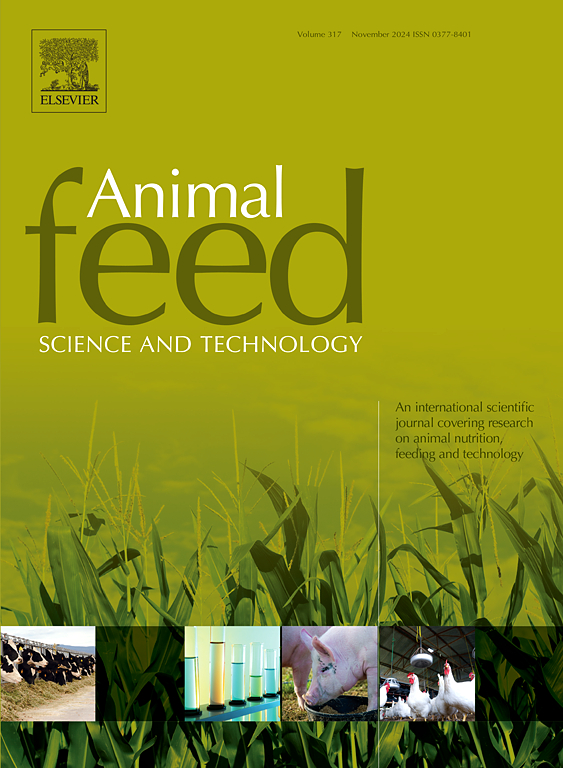Processing and soaking of sugar beet pulp changes the feeding behavior of horses
IF 2.5
2区 农林科学
Q1 AGRICULTURE, DAIRY & ANIMAL SCIENCE
引用次数: 0
Abstract
Sugar beet pulp (SBP) is an interesting alternative to high-starch cereals to provide sufficient energy for athletic horses without compromising their digestive and metabolic health. However, this ingredient has been associated with a risk of esophageal obstruction (EO) in epidemiological studies. The form in which SBP was offered in those studies was not reported, though it could alter ingestion. To support safe feeding of SBP to horses, this study aimed to compare the effect of three products differing by their processing (“SBP shreds”, “IS pellets”: pellets from integral SBP shreds, “GS pellets”: pellets from ground shreds), fed either dry or soaked, on intake and feeding behavior of horses with normal dentition. The hardness and hydration properties of the three products were determined. Each of the six SBP forms was offered [1 kg of dry matter (DM)] on the morning meal] to nine horses with ad libitum access to hay in a change-over design over a period of three consecutive days. On the first two days of each period, SBP meals were given in the horses’ usual boxes. Refusals were collected 90 min after distribution and weighed to determine DM intake. On the third day, feeding behavior of horses was observed during ten minutes in an experimental box. Swelling (P = 0.002) and water retention capacity (P < 0.001) were lower for shreds than for pellets, without difference between IS and GS pellets. GS pellets were softer than IS pellets. No EO were observed along the experimental periods. Horses spent less time masticating (P = 0.005) and more time in prehension (P < 0.001) when receiving shreds, while the time dedicated to mastication (especially away from the feeder, P < 0.001) was longer with the two dry pellets. Higher intake rates were measured with dry IS and GS pellets than dry shreds (P = 0.001). Similar feeding behavior was observed for the two dry pellets, but GS pellets led to a longer drinking duration (P = 0.034), suggesting less intense chewing and saliva production. Soaking did not modify DM intake but altered the feeding behavior. Compared to dry pellets, horses fed soaked SBP pellets increased their chewing intensity (P = 0.005), slowed down their intake rate (P = 0.001), spent less time walking around their box (P = 0.016) and spent more time in front of the feeder in prehension (P < 0.001). The feeding behavior of horses was not different between soaked pellets and shreds. Feeding these voluminous forms of SBP (shreds or soaked products) could be a strategy to reduce intake rate and increase chews/kg DM, providing more benefits to the health and welfare of horses.
甜菜浆的加工和浸泡改变了马的进食行为
甜菜浆(SBP)是一种有趣的高淀粉谷物替代品,可以在不影响马消化和代谢健康的情况下为马提供足够的能量。然而,在流行病学研究中,这种成分与食道梗阻(EO)的风险有关。在这些研究中,收缩压的形式没有报道,尽管它可能改变摄入。为了支持对马的SBP安全喂养,本研究旨在比较三种不同加工方式的产品(“SBP碎片”,“IS颗粒”:从完整的SBP碎片中提取的颗粒,“GS颗粒”:从磨碎的颗粒中提取的颗粒),干燥或浸泡饲喂对正常牙列马的摄入量和摄食行为的影响。测定了三种产物的硬度和水化性能。在连续3天的时间里,6种SBP形式中的每一种都在早餐时提供[1 kg干物质[DM]]给9匹马,在转换设计中可以自由地获得干草。在每个周期的前两天,在马的常用盒子里给予SBP餐。分发后90 分钟收集拒绝者并称重以确定DM摄入量。第三天,在实验箱中观察10分钟马的摄食行为。颗粒的溶胀率(P = 0.002)和保水率(P <; 0.001)低于颗粒,IS和GS颗粒之间无差异。GS颗粒比IS颗粒软。实验期间未观察到EO。马在吃碎料时咀嚼的时间更少(P = 0.005),抓握的时间更多(P <; 0.001),而在吃两粒干颗粒时,咀嚼的时间更长(特别是在远离喂食器的地方,P <; 0.001)。干IS和GS颗粒的采食量高于干撕碎(P = 0.001)。两种干颗粒的摄食行为相似,但GS颗粒的摄食时间较长(P = 0.034),表明咀嚼强度和唾液分泌较少。浸泡不改变DM摄取量,但改变了摄食行为。与干颗粒相比,浸泡过的SBP颗粒增加了马的咀嚼强度(P = 0.005),降低了马的进食速度(P = 0.001),减少了马在笼子周围走动的时间(P = 0.016),增加了马在喂食器前抓食的时间(P <; 0.001)。马的摄食行为在浸泡过的颗粒和碎料之间没有差异。饲喂这些大量形式的SBP(碎片或浸泡产品)可能是一种降低摄取率和增加咀嚼量/kg DM的策略,为马的健康和福利提供更多好处。
本文章由计算机程序翻译,如有差异,请以英文原文为准。
求助全文
约1分钟内获得全文
求助全文
来源期刊

Animal Feed Science and Technology
农林科学-奶制品与动物科学
CiteScore
6.00
自引率
6.20%
发文量
266
审稿时长
3 months
期刊介绍:
Animal Feed Science and Technology is a unique journal publishing scientific papers of international interest focusing on animal feeds and their feeding.
Papers describing research on feed for ruminants and non-ruminants, including poultry, horses, companion animals and aquatic animals, are welcome.
The journal covers the following areas:
Nutritive value of feeds (e.g., assessment, improvement)
Methods of conserving and processing feeds that affect their nutritional value
Agronomic and climatic factors influencing the nutritive value of feeds
Utilization of feeds and the improvement of such
Metabolic, production, reproduction and health responses, as well as potential environmental impacts, of diet inputs and feed technologies (e.g., feeds, feed additives, feed components, mycotoxins)
Mathematical models relating directly to animal-feed interactions
Analytical and experimental methods for feed evaluation
Environmental impacts of feed technologies in animal production.
 求助内容:
求助内容: 应助结果提醒方式:
应助结果提醒方式:


